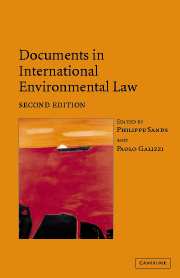Book contents
- Frontmatter
- Contents
- Preface
- PART I General instruments
- PART II Atmosphere
- PART III Oceans: global
- PART IIIB Oceans: regional
- PART IV Freshwater resources
- PART V Biodiversity
- PART VIA Hazardous substances and activities: nuclear
- PART VIB Hazardous substances and activities: pesticides
- PART VIC Hazardous substances and activities: waste
- PART VII Human rights and the environment
- PART VIII War and the environment
- PART IX Trade and the environment
- PART X Environmental impact assessment and access to information
- PART XI Liability for environmental damage and breaches of environmental obligations
- PART XII The Antarctic
- 47 Antarctic Treaty, 1 December 1959
- 47A Protocol on Environmental Protection to the Antarctic Treaty, 4 October 1991
- 48 Convention for the Conservation of Antarctic Seals, 1 June 1972
48 - Convention for the Conservation of Antarctic Seals, 1 June 1972
Published online by Cambridge University Press: 05 June 2012
- Frontmatter
- Contents
- Preface
- PART I General instruments
- PART II Atmosphere
- PART III Oceans: global
- PART IIIB Oceans: regional
- PART IV Freshwater resources
- PART V Biodiversity
- PART VIA Hazardous substances and activities: nuclear
- PART VIB Hazardous substances and activities: pesticides
- PART VIC Hazardous substances and activities: waste
- PART VII Human rights and the environment
- PART VIII War and the environment
- PART IX Trade and the environment
- PART X Environmental impact assessment and access to information
- PART XI Liability for environmental damage and breaches of environmental obligations
- PART XII The Antarctic
- 47 Antarctic Treaty, 1 December 1959
- 47A Protocol on Environmental Protection to the Antarctic Treaty, 4 October 1991
- 48 Convention for the Conservation of Antarctic Seals, 1 June 1972
Summary
Editorial note
The Convention for the Conservation of Antarctic Seals prohibits the capturing or killing of enumerate species of seal in the area south of 60° South Latitude, except as provided in theConvention (Article 2). In addition to theAnnexwhich specifies particular measures that Parties adopt to promote the ‘conservation, scientific study and rational and humane use of seal resources’ (Article 3). The Convention provides for the grant of permits to kill or capture ‘limited quantities’ of seals not in accordance with the Convention, if to do so will provide: ‘indispensable’ food to men and dogs; or for scientific research; or for museums, educational or cultural institutions (Article 4(1)).
The Scientific Committee on Antarctic Research of the International Council of Scientific Unions (SCAR) is to provide scientific advice to the Parties and act as a medium for information exchange (Article 5). The Convention requires Parties to follow the findings of SCAR on when the permissible catch limits are likely to be exceeded and to cease killing and capturing seals accordingly (Article 5(5)). Once commercial sealing begins in the Antarctic, the Convention requires Parties to enter into consultations with each other with a view to establishing: an ‘effective system of control, including inspection’ over the Convention's implementation; a Commission; and a Scientific Advisory Committee (Article 6(1)). Such consultations must take place at the request of a Party if SCAR reports that a particular harvest is having a ‘significantly harmful effect’ on the total stock or on the ecological system (Article 6(3)).
- Type
- Chapter
- Information
- Documents in International Environmental Law , pp. 1357 - 1364Publisher: Cambridge University PressPrint publication year: 2004



